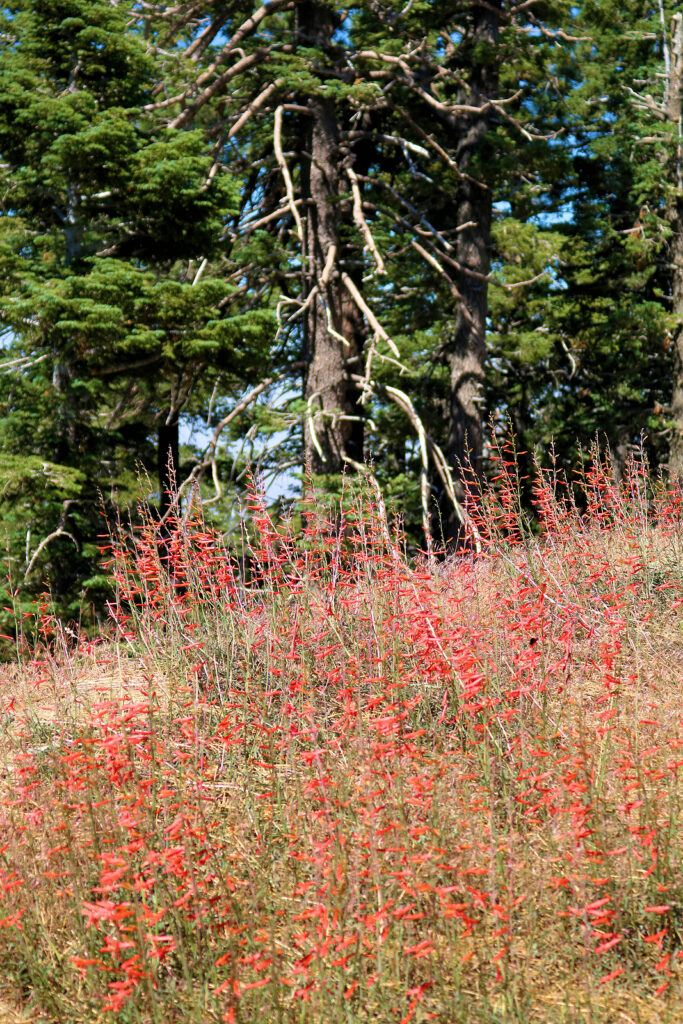Zauschneria–commonly called California fuchsia–is a rhizomatous perennial that bears tubular scarlet flowers to 2-inches long atop wiry stems. The narrow leaves are green to gray-green and often felted.
Zauschneria is a genus of 4 species native to the western United States and Mexico, primarily California and Baja California. Zauschneria is related to Fuchsia (true fuchsias) and Oenothera (evening primroses). Zauschneria is deciduous or semievergreen, depending on the species and where the plants are grown.
The bright red tubular flowers are absolute magnets for hummingbirds.
Zauschnerias require full sun and warm, well-drained soil. Plants will rot if moisture is allowed to stand in the soil at any time of the year.
Botanists have reclassified Zauschneria as Epilobium, reducing the number of species in the process. However, most nurseries sell the plants under the old name.
Get to know Zauschneria
- Plant type: Perennial grown from rhizomes
- Growing zones and range: Zones 8-11
- Hardiness: Hardy to 0°F (-18°C0
- Height and width: 12 to 24 inches (30-60cm) tall and 12 to 20 inches (30-50cm) wide
- Foliage: Linear-lance-shaped or broadly ovate leaves are stalkless
- Flowers: Tubular to funnel-shaped flwoers borne in terminal racemes
- Flower colors: Red, orange, pink, white
- Bloom time: Late summer and autumn
- Uses: Rock gardens, mixed or herbaceous borders
- Common name: California fuchsia
- Botanical name: Zauschneria
- Family name: Onagraceae
- Origin: Western North America

Where to plant Zauschneria
- Grow Zauschneria in full sun.
- Plant Zauschneria in moderately fertile, well-drained soil. Well-dug soil will benefit growth.
- Zauschneria spread by underground stems to make ever-larger colonies; they can be a nuisance in manicured gardens.
Zauschneria uses and companions
- Use Zauschneria in a mixed or herbaceous border or in a rock or naturalistic garden.
- Good garden companions for Zauschneria include Achillea filipendulina, Ceratostigma plumbaginoides, Eryngium, Gaura lindheimeri, Lobelia laxiflora, Oenothera, Perovskia Verbena.
When to plant Zauschneria
- Set container grown Zauschneria in the garden in spring or fall.
Planting and spacing Zauschneria
- Space Zauschneria 12 to 20 inches (30-50cm) apart.
How to water and feed Zauschneria
- Moderate watering is sufficient in dry summer regions; where the soil is heavy with clay stretch out the watering times.
- Fertilize Zauschneria with an all-purpose organic fertilizer in spring.
Zauschneria care
- Shelter Zauschneria from the wind.
- Plants can look ragged and ratty during winter; if cut to the ground, they resprout vigorously in spring.
- Where plants are marginally hardy they may benefit from a light cover of branches in winter, provided this does not trap water and moisture.
Zauschneria pests and diseases
- Young growth can be damaged by slugs.
Zauschneria propagation
- Zauschneria seeds will germinate in 1 to 2 months at 59° to 64°F (15°-18°C) in the light.
- Sow seeds in containers in a cold frame in spring.
- Root basal cuttings in spring with bottom heat.
- Rooted segments from establishe clumps can be set in the garden in spring.
Zauschneria varieties to grow
Botanists have reclassified Zauschneria as Epilobium, reducing the number of species in the process. However, most nurseries sell the plants under the old name.
- Zauchneria californica (Epilobium canum canum). Stems upright or somewhat arching, 1 to 2 feet tall, sometimes shrubby at the base. ‘Alba’ has white flowers; ‘Solidarity Pink’ bears soft pink blooms. ‘Dublin’ (‘Glasnevin’), to 1 foot tall, has scarlet blossoms; ‘Etteri’, to 6 in. high, has silvery leaves and scarlet flowers. Catalina’ is unusually tall and broad, with nearly white leaves and brilliant flower; ‘Cloverdale’ is a prostrate form; ‘Mattole Select’ makes low mounds of silvery foliage and scarlet flowers, but it does not spread readily.
- Z. cana (Epilobium canum canum). Differs from above species in its denser, more sprawling habit and in its more silvery leaf color.
- Z. latifolia (Epilobium canum latifolium). Most widely grown form is 2-feet tall ‘Arizonica’, with broad, light green leaves and bright orange blossoms.
- Z. septentrionalis (Epilobium septentrionale). Forms a mat of narrow, silvery gray-green leaves; bears orange-red flowers. Dies back yearly.















